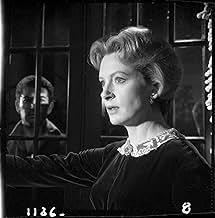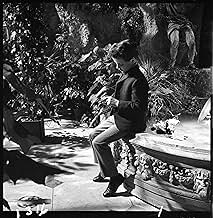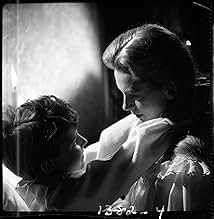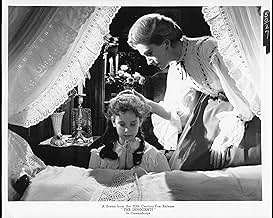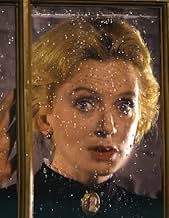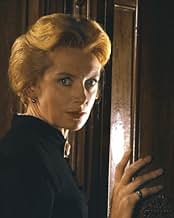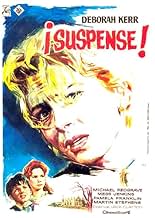Eine junge Erzieherin für zwei Kinder kommt zu der Überzeugung, dass es in Haus und Grundstück spukt.Eine junge Erzieherin für zwei Kinder kommt zu der Überzeugung, dass es in Haus und Grundstück spukt.Eine junge Erzieherin für zwei Kinder kommt zu der Überzeugung, dass es in Haus und Grundstück spukt.
- Nominiert für 2 BAFTA Awards
- 4 Gewinne & 5 Nominierungen insgesamt
Empfohlene Bewertungen
As outsiders looking in as voyeurs, we are left wondering about what the governess sees: are the children possessed? Or perhaps they have become friends with ghosts? Or is the governess simply paranoid? The film keeps us guessing, which only adds to its creepiness.
This title has the distinction of featuring the debut of Pamela Franklin, here playing the child Flora, who would later be memorable in "The Legend of Hell House". She expertly presents herself as innocent (hence the title) while saying creepy lines such as, "Oh, look, a lovely spider! And it's eating a butterfly." Did this inspire Jack Hill's "Spider Baby"?
The film has received wide critical acclaim for its psychological thrills and also its technological achievements (cinematographer Freddie Francis made the lightning his number one focus, and also shot the film in layers, giving it a deeper look than most movies). No less than Martin Scorsese has listed it among the greatest horror films ever made.
Freddie Francis is in top form here, coming off his Oscar win for "Sons and Lovers" (1960). His mark on the horror genre would only increase in the following years, as he took the director's chair for Amicus and Hammer numerous times in the 60s and 70s.
Deborah Kerr accepts a job as the governess of two strange children (Martin Stephens and Pamela Franklin) and becomes convinced that they occupy a world haunted by repressed memories and the restless dead.
Martin Stephens' performance as the unfathomable Miles is extraordinary. The child projects a physical authority rare for his years. His dialog exchanges with Kerr run the gamut from highly amusing to deeply disturbing.
Clayton's greatest achievement is the way he subverts common household settings to the point where they become arenas of fear.
The sound design is chilling, conjuring sudden terror and thrusting us into the complex mechanics of the Kerr character's growing paranoia.
Strikingly shot and lit, the film is a textbook example of grave cinematic suggestion.
Watching the movie, I could see some similarities to "The Shining" and "The Others". It just goes to show that real horror comes not from blood and guts, but from what the viewer doesn't know. There were a few scenes in this movie that made my blood freeze a little bit. Without a doubt it was a solid achievement for Clayton, Kerr, and also Truman Capote (who co-wrote the screenplay). Definitely one that I recommend.
Based on Henry James' novella, "The Turn Of The Screw," the story is deceptively simple. An inexperienced governess is hired to care for two orphaned children in an isolated British manor and slowly comes to believe the ghosts of the previous governess and her brutish lover are trying to possess the children's souls. Being a decent woman "who loves children," she fights back the only way she can -- by confronting the evil head on. But the question is, does the evil truly exist...or is it all in her own mind?
As told by James, the novella is a startling ghost story, without question. He adds his usual psychological insights to the characters, but never do you doubt the ghosts exist. The defining moment comes when Miss Giddens sees Quint's face in a dark window then later finds a locket bearing his portrait and comes to her realization, "Oh, he's a ghost!" But in the movie, Truman Capote and William Archibald reverse this sequence -- she finds the locket first and THEN sees the man's face in the window -- and all simple explanations go out the door.
Is Miss Giddens imagining things? Has she become overwhelmed by the responsibility of raising two precocious children without any sort of support from their selfish uncle? Is she merely sexually repressed and immature enough to transfer her crush on the uncle to a boy not even into puberty yet? And what of Flora, Miles' sister? If this is merely sexual repression on Miss Giddens' part, then why does she drag a little girl into the morass? Throughout the film, Miss Giddens offers evidence of her concerns -- a letter received from Miles' schoolmaster that she cannot fully share with Mrs. Grose because the woman cannot read; her awareness that the two innocents in her charge have a far more advanced knowledge of life than children that age normally would; stories told by Mrs. Grose about Miss Jessel and Quint and how they treated the children. So could it be the spirits of two miserable adults have come back to reclaim life in the persons of Miles and Flora? It could go either way.
There is not one wrong moment in this movie. Not one. The first time I saw it was in New York City on a double bill with "The Haunting" (1963), a "things that go bump in the night" kind of movie. The audience and I howled through that one, it was so much silly fun. And we chuckled through the first ten minutes of "The Innocents" (especially when Mrs. Grose tells Miss Giddens, "I'm SO glad you're here," with a little quiver in her voice), but by the end of that film (and I use the word "film" deliberately), the entire theater was dead silent. Any film that can shut up a room full of rowdy New Yorkers has got to be damned good.
So...is "The Innocents" a ghost story or psychological study? Who can say? And to be honest, who cares? It is, at the very least, a damned good movie...and at the very best, a horror story that makes "The Shining," "Rosemary's Baby," "The Others" and even "Psycho" (a movie I love) look like the works of children. That this film is not available on DVD is a travesty.
The first screen adaptation of Henry James's "The Turn of the Screw, " a psychological ghost story that leaves unanswered the question of whether the ghosts are real or imagined. This sort of story is pretty common in movies of the last 20 years but was much less so in 1898 or even 1961. Don't let the ambiguity put you off that there are no scares here. This is a movie full of spooky moments, shadowy figures, startling reflections, eerie voices. It's beautifully photographed by Freddie Francis. The music and sound effects add to the feeling of unease. Deborah Kerr gives a nail-biting performance as the neurotic, repressed Miss Giddens. The child actors, Pamela Franklin and Martin Stephens, are sufficiently precocious and weird to keep you off balance as to the truth behind their possession. Stephens was the leader of the kids in Village of the Damned. Franklin would go on to appear in such '70s greats as And Soon the Darkness and The Legend of Hell House. Megs Jenkins is good as the kindly housekeeper. Peter Wyngarde is creepy as the menacing Quint.
The pace is slow, which will turn off impatient viewers, and the scares are subtle and not as visceral as most modern horror fans seem to enjoy. But if you like thoughtful horror films then this is one you'll want to see. Fans of the suggestive classics Val Lewton produced in the '40s should also check this out.
Wusstest du schon
- WissenswertesTo create such sharp visuals, director of photography Freddie Francis used lots of huge bright lamps. Deborah Kerr sometimes had to resort to wearing sunglasses between takes. He also had candles custom made with four or five wicks entwined to produce more light.
- PatzerAn obvious center back zipper in several of Miss Kerr's costumes, as well as in Mrs. Gross & Flora's costumes. The Innocents is set during the Victorian period, 1837-1901. Commercial zippers were not used in clothing until 1925.
- Zitate
Miles: What shall I sing to my lord from my window? What shall I sing for my lord will not stay? What shall I sing for my lord will not listen? Where shall I go when my lord is away? Whom shall I love when the moon is arisen? Gone is my lord and the grave is his prison. What shall I say when my lord comes a calling? What shall I say when he knocks on my door? What shall I say when his feet enter softly? Leaving the marks of his grave on my floor. Enter my lord. Come from your prison. Come from your grave, for the moon is a risen. Welcome, my lord.
- Crazy CreditsThe film begins with a totally black screen and the sound of Flora singing for several seconds; then the 20th Century Fox logo fades in and out. The singing continues for a few seconds before the opening credits begin. As the credits display, we see an anguished Miss Giddens praying on the left side of the screen. Her actions are not explained until the film's climax.
- VerbindungenFeatured in Aweful Movies with Deadly Earnest: The Innocents (1974)
Top-Auswahl
Details
- Erscheinungsdatum
- Herkunftsländer
- Sprache
- Auch bekannt als
- Posesión satánica
- Drehorte
- Produktionsfirma
- Weitere beteiligte Unternehmen bei IMDbPro anzeigen
Box Office
- Budget
- 430.000 £ (geschätzt)
- Weltweiter Bruttoertrag
- 30.411 $
- Laufzeit
- 1 Std. 40 Min.(100 min)
- Farbe
- Seitenverhältnis
- 2.35 : 1



